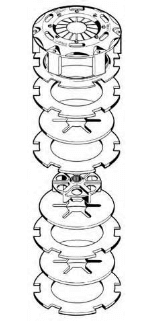Carbon-carbon clutches and limited slip differentials: In the early 1980s, carbon-carbon clutches were tried for drag racers, but it was not until 1984, when H company supplied carbon-carbon clutch plates to Tilton Engineering Inc. For evaluation, that any real progress was made. Tilton then developed 2- and 3- plate clutches. Advantages are weight saving; improved wear resistance; resistance to hydraulic fluids; reduction in moment of inertia, centrifugal force and kinetic energy, permitting

fig.23.52-Tilton 3plate carbon-carbon clutch
enhanced engine response and faster gear shifting; and reduced weight at the flywheel end. The clutches are supplied in many configurations and a typical 3-plate clutch is shown in Figure 23.52. As the temperature increases, the clutch grips better, but above 400C, the wear rate increases due to oxidation. It is believed that as the disk rotates faster, the oxidation debris is thrown from the friction surface, reducing the wear rate, whereas at lower velocities, the particles remain on the friction surface and increase the rate of wear.
AP Racing has developed a series of clutches and currently supplies nine out of eleven F1 racing teams. Clutches are made with up to 9 plates.
H company, working in conjunction with the Eaton Corporation, has supplied carbon fiber fabric densified with CVD carbon, which is then bonded to a metal backing plate for use as oil immersed limited slip differential. They are used in rear-wheel drive cars and light trucks. Carbon disks are positioned behind each side gear and preloaded with a central spring assembly. Pyrolytic carbon bonded to steel discs are alternated with non-patterned steel disks, creating a clutch pack that restricts the relative wheel rotation and provides more driving force to the wheel with the greatest traction.
Carbon-carbon in space:
The shuttle rockets, when taking off, exceed speeds of 27,000km/h and the temperature generated on the wing leading edges and nose cone reaches 1370C, whilst on re-entry, the temperature is even higher, reaching 1650C. Carbon-carbon is an ideal material for these applications, resisting thermal shock from -158C in space to 1650C on re-entry. Another virtue of carbon-carbon is that as the temperature increases, so does the strength. For ablative applications, it is important that the carbon-carbon has a low thermal conductivity and this is best provided by a carbon fiber made from a cellulosic precursor.
In the 1970s, carbon-carbon leading edges and nose cones were required for the space shuttle and were made using a rayon based precursor. The nose cone, for example, comprised of a two-dimensional lay-up using a phenolic carbon prepreg, which was positioned in a mold, cured, trimmed to size and pyrolyzed. The composite was then impregnated three times with furfuryl alcohol and pyrolyzed after each impregnation. To confer a measure of oxidation resistance, the pack conversion process was used, applying a SiC powder on the inside and outside surfaces and firing at 1650C to form a surface layer. Since the SiC is brittle and has a divergent coefficient of expansion, the SiC layer does tend to spall, so it was further protected with repeated applications of tetraethyl-orthosilicate, using a strong mineral acid as catalyst, which when gelled and heated, formed a fluxed SiO2 glaze, which further reduced the exposed area of carbon.
The carbon-carbon leading edges of the shuttle transfer the aerodynamic forces to the Al substructure and to ensure that the temperature of the Al did not exceed 180C, a layer of insulation was positioned between the carbon-carbon and Al. The carbon-carbon leading edge can safely withstand the impact from meteors without fracturing.